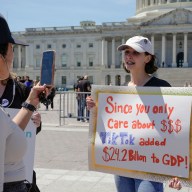Twelve months after their rescue from being buried 700 meters deep, the 33 men still get recognition for the instant fame and status given by the tragedy.
However, contrary to belief, nowadays for many of them their situation may be even worse than before the accident, finding themselves without a steady job in most of their cases or still on medical leave.
On the other hand, former employers Alejandro Bohn and Marcelo Kemeny, owners of San Esteban Mining Company that managed the deposit, still walk freely in the country and have only faced the prosecutor’s investigation.
Officially, only the Commission on Work Safety established after the incident has made them responsible as well as Chile’s mining regulatory agency (Sernageomin) and Atacama’s Regional Secretary of Health for their actions.
Back on the surface and after gathering back for the first time since their accident, the miners were invited to visit many countries like Spain, Israel, Greece, the UK and America. Out of all those trips, the one who caught most of the media attention was a special tribute by CNN held in Los Angeles, where they sang Chile’s national anthem and got a standing ovation from Hollywood’s biggest stars like Demi Moore and Jessica Alba.
“Los 33” want to monetize their experience and to that end they hired the Carey and Company law firm, establishing a society in order to protect their image and sell their story. They also signed a deal with the William Morris Endeavor agency for future movie and television projects. Well-known Hollywood producer Mike Medavoy will also make a movie of their story based on a book by Pulitzer winner Héctor Tobar, which was inspired by Victor Segovia’s writings underground.
Deciding to seek justice, part of them sued the Chilean State for negligence by not securing the proper working conditions at San José mine. Besides the lawsuit, fourteen were given a $470 a month pension from the government of Chilean President Sebastian Piñera.
Where are the miners today?
- Mario Sepúlveda, age 41: The extroverted miner owns an event center in Santiago.
- Mario Gómez, age 65: Suffering from silicosis and wants to retire. Gets a discretionary pension from the government.
- Víctor Zamora, age 34: Has no steady job, but uses his house’s living room for selling out fruits and vegetables. Still dealing with insomnia problems.
- Franklin Lobos, age 53: Currently technical coordinator of Copiapó’s football club development leagues. Gets a discretionary pension from the government.
- Claudio Acuña, age 36: Despite the trauma caused by the accident, after failed attempts of getting a new job he only got accepted back in mining.
- Víctor Segovia, age 49: Owns a taxi cab and a school bus. A book based on the accident will be written thanks to his writings under-ground. Gets a discretionary pension from the government.
- Ariel Ticona, age 30: He spends with time at home with his daughter Esperanza, born during his days trapped underground. Also unemployed and experiencing stress.
- Daniel Herrera, age 28: As a part of his therapy, he makes public appeareances in a special hall dedicated to the miners at Santa Cruz Museum. Also on medical leave.
- José Ojeda, age 48: On medical leave, still afflicted by being trapped underground. Gets a discretionary pension from the government.
- Pablo Rojas, age 46: Unemployed. Gets a pension from the government.
- Omar Reygadas, age 57: Unemployed, working as motivational speaker. Gets a discretionary pension from the government.
- Alex Vega, age 32: Has no steady job, but does temporary jobs as mechanic. Currently on medical leave.
- Samuel Ávalos, age 44: Unemployed, working as motivational speaker.
- Renán Ávalos, age 30: Dealing with psychological problems.
- Florencio Ávalos, age 32: Unemployed but applying for a job as miner at Collahuasi copper mine, northern Chile.
- Yonni Barrios, age 51: The group’s “nurse” is suffering from silicosis. Owns a warehouse along with wife Susana Valenzuela, but earnings can’t afford him a good living. Gets a discretionary pension from the government.
- Darío Segovia, age 49: Opened a greengrocer in Copiapó thanks to funding from Leonardo Farkas, Chilean businessman and philanthropist. Gets a discretionary pension from the government.
- Luis Urzúa, age 55: Currently dedicated on giving motivational talks along his colleagues. Gets a pension from the government.
- Juan Andrés Illanes, age 53: Working as motivational speaker. Gets a discretionary pension from the government.
- Juan Carlos Aguilar, age 50: Training to become a motivational speaker. Gets a discretionary pension from the government.
- Edison Peña, age 35: Being treated for drug and alcohol addiction at a rehab clinic.
- Claudio Yáñez, age 35: Formally unemployed and dealing with financial issues, he’s currently focused on giving motivational talks.
- Osmán Araya, age 31: Unemployed and dealing with psychological problems. Not receiving any type of help from the government.
- Carlos Mamani, age 25: The Bolivian miner is currently unemployed and still living in Chile. He is not giving interviews.
- Richard Villarroel, age 28: Dealing with psychological problems.
- Jimmy Sánchez, age 20: Discharged from hospital, but still dealing with psychological problems.
- Raúl Bustos, age 41: Currently living in Talcahuano (southern Chile) and focused on motivational speaking.
- Pedro Cortés, age 27: Unemployed and bankrupt, studying electrical technology.
- Carlos Bugueño, age 28: Unemployed. Relies on charity.
- Esteban Rojas, age 45: Unemployed and gets a discretionary pension from the government.
- Carlos Barrios, age 28: Gets an income through a friend’s job using a working vehicle.
- Jorge Galleguillos, age 56: Has no formal job, dedicated on giving motivational talks. Gets a discretionary pension from the government.
- José Henríquez, age 55: Told his story for the book “Miracle in the Mine,” available in Spanish and English on October 12. Doesn’t have a formal job but is decided to continue working as a miner. Gets a discretionary pension from the government.















